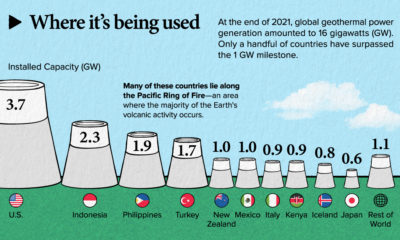By the end of the 19th century, wind energy took on a whole new meaning as engineers in Scotland, Denmark, and the United States invented the first wind turbines that generated electricity. Many technological improvements have been made since, and now modern wind farms dot the landscapes of countries around the world. Related Topic: What it Would Take to Power New York City Today, wind power is an important element of the green energy mix, and its estimated that 432 GW of wind farms are installed globally. In the United States, nearly 5% of all power is now generated by wind.
How Wind Turbines Work
How do these massive propellers get into motion? Once they are turning, what do they do? As shown in the animation, it’s all about the lift and drag forces created by the shape of the blades. Lift acts perpendicular to the direction of wind flow and drag acts parallel to the direction of wind flow.
The blades are designed so that when wind passes, a low-pressure pocket of air is created by faster moving wind on the curved side of the blade. This sucks the blade in the downwind direction, creating lift. The blades are then connected to a series of shafts that spin an electromagnetic induction generator, and this creates electricity. There are some other bells and whistles that help to maximize efficiency in a modern wind turbine as well. The anemometer measures wind speed, while the controller starts and stops the turbines to operate only at desirable wind speeds (between 8 and 55 kmph). The wind vane measures the wind’s direction and communicates this information to the yaw drive, which helps make adjustments to the turbine’s orientation. Lastly, there is also a braking system installed which can be used for emergency stops when wind speeds get too extreme. Original graphic by: SaveOnEnergy
on
#1: High Reliability
Nuclear power plants run 24/7 and are the most reliable source of sustainable energy. Nuclear electricity generation remains steady around the clock throughout the day, week, and year. Meanwhile, daily solar generation peaks in the afternoon when electricity demand is usually lower, and wind generation depends on wind speeds.As the use of variable solar and wind power increases globally, nuclear offers a stable and reliable backbone for a clean electricity grid.
#2: Clean Electricity
Nuclear reactors use fission to generate electricity without any greenhouse gas (GHG) emissions.Consequently, nuclear power is the cleanest energy source on a lifecycle basis, measured in CO2-equivalent emissions per gigawatt-hour (GWh) of electricity produced by a power plant over its lifetime. The lifecycle emissions from a typical nuclear power plant are 273 times lower than coal and 163 times lower than natural gas. Furthermore, nuclear is relatively less resource-intensive, allowing for lower supply chain emissions than wind and solar plants.
#3: Stable Affordability
Although nuclear plants can be expensive to build, they are cost-competitive in the long run. Most nuclear plants have an initial lifetime of around 40 years, after which they can continue operating with approved lifetime extensions. Nuclear plants with lifetime extensions are the cheapest sources of electricity in the United States, and 88 of the country’s 92 reactors have received approvals for 20-year extensions. Additionally, according to the World Nuclear Association, nuclear plants are relatively less susceptible to fuel price volatility than natural gas plants, allowing for stable costs of electricity generation.
#4: Energy Efficiency
Nuclear’s high energy return on investment (EROI) exemplifies its exceptional efficiency. EROI measures how many units of energy are returned for every unit invested in building and running a power plant, over its lifetime. According to a 2018 study by Weissbach et al., nuclear’s EROI is 75 units, making it the most efficient energy source by some distance, with hydropower ranking second at 35 units.
#5: Sustainable Innovation
New, advanced reactor designs are bypassing many of the difficulties faced by traditional nuclear plants, making nuclear power more accessible.
Small Modular Reactors (SMRs) are much smaller than conventional reactors and are modular—meaning that their components can be transported and assembled in different locations. Microreactors are smaller than SMRs and are designed to provide electricity in remote and small market areas. They can also serve as backup power sources during emergencies.
These reactor designs offer several advantages, including lower initial capital costs, portability, and increased scalability.
A Nuclear-Powered Future
Nuclear power is making a remarkable comeback as countries work to achieve climate goals and ultimately, a state of energy utopia. Besides the 423 reactors in operation worldwide, another 56 reactors are under construction, and at least 69 more are planned for construction. Some nations, like Japan, have also reversed their attitudes toward nuclear power, embracing it as a clean and reliable energy source for the future. CanAlaska is a leading exploration company in the Athabasca Basin, the Earth’s richest uranium depository. Click here to learn more now. In part 3 of the Road to Energy Utopia series, we explore the unique properties of uranium, the fuel that powers nuclear reactors.





























